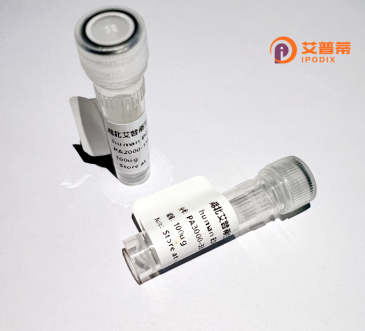
| 纯度 | >90%SDS-PAGE. |
| 种属 | Human |
| 靶点 | PCTK1 |
| Uniprot No | Q00536 |
| 内毒素 | < 0.01EU/μg |
| 表达宿主 | E.coli |
| 表达区间 | 1-496 aa |
| 活性数据 | MDRMKKIKRQ LSMTLRGGRG IDKTNGAPEQ IGLDESGGGG GSDPGEAPTR AAPGELRSAR GPLSSAPEIV HEDLKMGSDG ESDQASATSS DEVQSPVRVR MRNHPPRKIS TEDINKRLSL PADIRLPEGY LEKLTLNSPI FDKPLSRRLR RVSLSEIGFG KLETYIKLDK LGEGTYATVY KGKSKLTDNL VALKEIRLEH EEGAPCTAIR EVSLLKDLKH ANIVTLHDII HTEKSLTLVF EYLDKDLKQY LDDCGNIINM HNVKLFLFQL LRGLAYCHRQ KVLHRDLKPQ NLLINERGEL KLADFGLARA KSIPTKTYSN EVVTLWYRPP DILLGSTDYS TQIDMWGVGC IFYEMATGRP LFPGSTVEEQ LHFIFRILGT PTEETWPGIL SNEEFKTYNY PKYRAEALLS HAPRLDSDGA DLLTKLLQFE GRNRISAEDA MKHPFFLSLG ERIHKLPDTT SIFALKEIQL QKEASLRSSS MPDSGRPAFR VVDTEF |
| 分子量 | 55.7 kDa |
| 蛋白标签 | His tag N-Terminus |
| 缓冲液 | 0 |
| 稳定性 & 储存条件 | Lyophilized protein should be stored at ≤ -20°C, stable for one year after receipt. Reconstituted protein solution can be stored at 2-8°C for 2-7 days. Aliquots of reconstituted samples are stable at ≤ -20°C for 3 months. |
| 复溶 | Always centrifuge tubes before opening.Do not mix by vortex or pipetting. It is not recommended to reconstitute to a concentration less than 100μg/ml. Dissolve the lyophilized protein in distilled water. Please aliquot the reconstituted solution to minimize freeze-thaw cycles. |
以下为3篇与重组人PCTK1蛋白相关的文献摘要简述:
1. **文献名称**:*"PCTK1 phosphorylates p27Kip1 and regulates its interaction with cyclin D-CDK4"*
**作者**:S. Yoshida et al.
**摘要**:研究利用重组PCTK1蛋白揭示了其对p27Kip1蛋白的磷酸化作用,证明此磷酸化调控p27与cyclin D-CDK4复合体的结合,影响细胞周期G1/S期转换。
2. **文献名称**:*"Expression and characterization of recombinant human PCTK1 in a bacterial system"*
**作者**:L. Wang et al.
**摘要**:报道通过大肠杆菌表达系统制备重组人PCTK1蛋白,优化纯化条件并获得高活性激酶,为后续体外酶学及药物筛选研究提供工具。
3. **文献名称**:*"The role of PCTK1 in neuronal differentiation: Insights from knockdown and recombinant protein rescue experiments"*
**作者**:M. Chen & R. Tanaka
**摘要**:通过siRNA敲低PCTK1并外源添加重组蛋白,证明PCTK1通过调控MAPK信号通路促进神经突生长,提示其在神经元分化中的关键作用。
PCTK1 (PCTAIRE kinase 1), also known as cyclin-dependent kinase 16 (CDK16), is a serine/threonine protein kinase belonging to the CDK family. Unlike classical CDKs involved in cell cycle regulation (e.g., CDK1 or CDK2), PCTK1 exhibits distinct functional characteristics and regulatory mechanisms. It is ubiquitously expressed in humans, with higher levels observed in the brain, testes, and proliferating cells. Structurally, PCTK1 contains a conserved kinase domain and unique N- and C-terminal regions that mediate protein interactions and subcellular localization. Unlike most CDKs, PCTK1 activation does not strictly depend on cyclin binding; instead, it interacts with cyclin Y or cyclin Y-like proteins, and its activity is modulated by phosphorylation and protein partners.
PCTK1 plays diverse roles in cellular processes, including cell cycle progression (particularly G2/M phase regulation), vesicular trafficking, neuronal development, and spermatogenesis. It participates in signaling pathways such as Wnt and TGF-β, influencing cell differentiation and apoptosis. Dysregulation of PCTK1 has been linked to multiple pathologies, including cancers (e.g., breast, liver, and prostate), neurodegenerative disorders, and male infertility. Overexpression in tumors often correlates with poor prognosis, suggesting its potential as a therapeutic target.
Recombinant human PCTK1 protein, produced via bacterial or eukaryotic expression systems, serves as a critical tool for studying its biochemical properties, substrate specificity, and inhibitor screening. Its production enables structure-function analyses and drug discovery efforts targeting PCTK1-associated diseases.
×